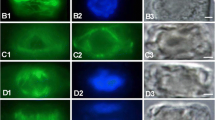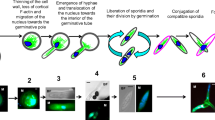Summary
Protonemata ofFunaria hygrometrica were exposed to the herbicidal MT inhibitor oryzalin. A reduction of the growth rate together with a disturbance of oriented polar growth is observed. Both effects are reversible. Visualization of MT by IFT reveals differential sensitivities of MT. At lower concentrations (⩽10−6 M) only the cytoplasmic MT are depolymerized causing impairment of the migration of the nucleus and the transport of the plastids. Close association of MT with the surface of the plastids is demonstrated. At higher concentrations of oryzalin spindle and phragmoplast MT are affected as well. They are found in unusual orientations and display a variety of aberrant forms like multipolar spindles or the occurrence of several “mini-spindles” within one cell. The mode of action of oryzalin is discussed and the necessity of a continuous network of cytoplasmic MT between nucleus and growing tip for the maintenance of polar growth is emphasized.
Similar content being viewed by others
Abbreviations
- CIPC:
-
isopropylN-3-chlorophenyl carbamate
- DAPI:
-
Diamidino-2-phenylindol
- DMSO:
-
dimethyl sulfoxide
- EGTA:
-
ethy-leneglycol-tetraacetic acid
- FITC:
-
fluorescein isothiocyanate
- IFT:
-
indirect immunofluorescence technique
- IPC:
-
isopropylN-phenylcar-bamate
- MSB:
-
microtubule stabilizing buffer
- MT:
-
microtubule
- MTOC:
-
microtubule organizing centre
- Ph:
-
phragmoplast
- PIPES:
-
piperazine-diethane sulfonic acid
- S:
-
spindle
References
Bajer AS, Molé-Bajer M (1984) Drugs with colchicin-like effects that specifically dissasemble plant but not animal microtubules. Ann New York Acad Sci 466: 767–784
Bartels PC, Hilton JL (1973) Comparison of trifluralin, oryzalin, pronamide, propham, and cholchicine treatments on microtubules. Pest Biochem Phys 3: 462–472
Bayer DE, Foy CL, Mallory TE, Cutter EG (1967) Morphological and histological effects of trifluralin on root development. Am J Bot 54: 945–952
Brown DL, Bouck GB (1974) Microtubule biogenesis and cell shape inOchromonas. III. Effects of the herbicidal mitotic inhibitor isopropylN-phenylcarbamate on shape and flagellum regeneration. J Cell Biol 61: 514–536
Brown RC, Lemmon BE (1987) Division polarity, development and configuration of microtubule arrays in bryophyte meiosis I. Meiotic prophase to metaphase I. Protoplasma 137: 84–99
Coss RA, Pickett-Heaps JD (1974) The effects of isopropylN-phenyl carbamate on the green algaOedogonium cardiacum I. Cell Division. J Cell Biol 63: 84–98
Doonan JH, Cove DJ, Lloyd CW (1985) Immunofluorescence microscopy of microtubules in intact cell lineages of the moss,Physcomitrella patens I. Normal and CIPC-treated tip cells. J Cell Sci 75: 131–174
—,Jenkins GI, Cove DJ, Lloyd CW (1986) Microtubules connect the migrating nucleus to the prospective division site during side branch formation in the moss,Physcomitrella patens. Eur J Cell Biol 41: 157–164
Hardham AR, Gunning BES (1979) Interpolation of microtubules into cortical arrays during cell elongation and differentiation in roots ofAzolla pinnata. J Cell Sci 37: 411–442
Hepler PK, Jackson WT (1969) IsopropylN-Phenylcarbamate affects spindle microtubule orientation in dividing endosperm cells ofHaemanthus katherinae Baker. J Cell Sci 5: 727–743
Hertel C, Quader H, Robinson DG, Marmé D (1980) Anti-mi-crotubular herbicides and fungicides affect Ca2+-transport in plant mitochondria. Planta 149: 336–340
— — —,Roos I, Carafoli E, Marmé D (1981) Herbicides and fungicides stimulate Ca2+ efflux from rat liver mitochondria. FEBS Letters 127: 37–39
Hess FD (1979) The influence of the herbicide trifluralin on flagellar regeneration inChlamydomonas. Exp Cell Res 119: 99–109
—,Bayer DE (1974) The effect of trifluralin on the ultrastructure of dividing cells of the root meristem of cotton (Gossypium hirsutum L.“Acala 4–42”). J Cell Sci 15: 429–441
— — (1977) Binding of the herbicide trifluralin toChlamydomonas flagellar tubulin. J Cell Sci 24: 351–360
Kiermayer O (1972) Beeinflussung der postmitotischen Kernmi-gration vonMicrasterias denticulata Bréb. durch das Herbizid Trifluralin. Protoplasma 75: 421–426
Morejohn LC,Bureau TE,Fosket DD (1983) Oryzalin binds to plant tubulin (T) and inhibits taxol-induced microtubule (MT) assemblyin vitro. J Cell Biol Abstr 211a
Quader H, Deichgräber G, Schnepf E (1986) The cytoskeleton ofCobaea seed hairs: Patterning during cell-wall differentiation. Planta 168: 1–10
—,Filner P (1980) The action of antimitotic herbicides on flagellar regeneration inChlamydomonas rheinhardtii: a comparison with the action of cholchicine. Eur J Cell Biol 21: 301–304
-,Schnepf E (1988) Immunofluorescence studies on microtubules ofFunaria hygrometrica protonema cells: Pattern and association with organelles. Botanica Acta, submitted
—,Wagenbreth I, Robinson DG (1978) Structure, synthesis and orientation of microfibrils. V. On the recovery ofOocystis solitaria from microtubule inhibitor treatment. Eur J Cell Biol 18: 39–51
Raff EC (1979) The control of microtubule assemblyin vivo. Int Rev Cytol 59: 1–96
Robinson DG, Herzog W (1977) Structure, synthesis and orientation of microfibrils III. A survey of the action of microtubule inhibitors on mirotubules and microfibril orientation inOocystis solitaria. Cytobiologie 15: 463–474
Schliwa M (1986) The cytoskeleton: An introductory survey. Springer, Wien New York (Cell Biology Monographs, Vol 13, pp 47- 82)
Schmiedel G, Schnepf E (1979) Side branch formation and orientation in the caulonema of the moss,Funaria hygrometrica: Normal development and fine structure. Protoplasma 100: 367–383
— — (1979) Side branch formation and orientation in the caulonema of the moss,Funaria hygrometrica: Experiments with inhibitors and with centrifugation. Protoplasma 101: 47–59
— — (1980) Polarity and growth of caulonema tip cells of the mossFunaria hygrometrica. Planta 147: 405–413
Schnepf E (1982) Morphogenesis in moss protonemata. In:Lloyd CW (ed), The cytoskeleton in plant growth and development. Academic Press, London, pp 321–344
— (1986) Cellular polarity. Ann Rev Plant Physiol 37: 23–47
—,Hrdina B, Lehne A (1982) Spore germination, development of the microtubule system and protonema cell morphogenesis in the moss,Funaria hygrometrica: Effects of inhibitors and growth substances. Biochem Physiol Pflanzen 177: 461–482
—,Quader H (1987) Functions of microtubules in plant cells. In: Nature and function of cytoskeletal proteins, Progress in Zoology 34, Fischer, Stuttgart New York, in press
Sievers A, Schnepf E (1981) Morphogenesis and polarity of tubular cells with tip growth. In:Kiermayer O (ed), Cytomorphogenesis in plants. Springer, Wien New York (Cell Biology Monographs, Vol 8, pp 265–299)
Strachan SD, Hess (1983) The biochemical mechanism of action of the dinitroaniline herbicide oryzalin. Pest Biochem Physiol 20: 141–150
Vogelmann ThC, Bassel AR, Miller JH (1981) Effects of micro-tubule-inhibitors on nuclear migration and rhizoid differentiation in germinating fern spores (Onoclea sensibilis). Protoplasma 109: 295–316
Wacker I, Reiss H-D, Schnepf E, Traxel K, Bauer R (1986) Polar distribution of calcium- and phosphorus-rich globules induced by glutaraldehyde/tannic acid fixation in the caulonema tip cell of the moss,Funaria hygrometrica: light microscopy, transmission electron microscopy (TEM), proton microprobe (PIXE), and electron spectroscopic imaging (ESI). Eur J Cell Biol 40: 94–99
Author information
Authors and Affiliations
Additional information
Dedicated to Prof. Dr. K. E.Wohlfarth-Bottermann on the occasion of his 65th birthday.
Rights and permissions
About this article
Cite this article
Wacker, I., Quader, H. & Schnepf, E. Influence of the herbicide oryzalin on cytoskeleton and growth ofFunaria hygrometrica protonemata. Protoplasma 142, 55–67 (1988). https://doi.org/10.1007/BF01273226
Received:
Accepted:
Issue Date:
DOI: https://doi.org/10.1007/BF01273226




